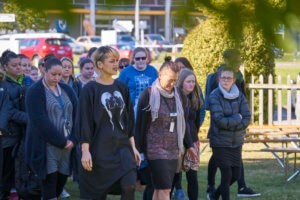 EIT has been commended for its progress in lifting Maori achievement rates in tertiary education.
EIT has been commended for its progress in lifting Maori achievement rates in tertiary education.
The Tertiary Education Commission is telling institutions to improve the results for their Maori and Pasifika students, or some of their funding could be at risk.
Deputy chief executive Paora Ammunson says that nationally there is a 20 percent gap in completion of level 7 and above degrees between Maori and Pasifika and other New Zealanders.
A five-year turnaround was possible and he warned others they might lose funding if they did not follow suit.
He is reported as saying that EIT in Gisborne and Hawke’s Bay are showing the way.
EIT chief executive Chris Collins welcomes the comments but says the process is an ongoing priority at EIT, which aims to continue to improve education outcomes for its Maori and Pasifika students.
“It is a strategic priority at the front of mind for all our staff,” he says. “We are committed to student achievement.
“We have been focusing on this for many years. We are encouraged by the improvements we are achieving in this area but there is still work to do.”
Mr Ammunson says there are many factors when it comes to Maori and Pasifika students underachieving.
“The learners who struggle the most are often the first in their family to go to tertiary study. They might be looking after a child on their own. They might have to drive a couple of hours to get to the institution. They might struggle with enrolment. They might take an inappropriate study load,” he said.
EIT staff are well aware of these types of issues, says Mr Collins.
They’re trained to factor them in, offering such things as flexibility in study hours and remedial sessions where possible.
The institute has achieved the highest Maori participation rate in the country — 72 percent in Tairawhiti and 43 percent in Hawke’s Bay –—and has a strong focus on meeting students’ needs.
“Supporting the achievement of these students is as much about the staff as the students.”
EIT chief Maori adviser Tuhakia Keepa has a leadership role that focuses on building strategies to improve the institute’s ability to meet the needs of Maori students and Maori communities.
“The key to that is finding out what people’s aspirations are and tailoring our support to those aspirations, and providing the steps they need to take to get there,” he says.
Mr Keepa believes one of the key challenges over the next few years will be catering to a growing number of students fluent in te reo.
EIT will need to increase its capability to engage with these students in all facets of education — from automotive and carpentry to business studies and computing.
The other challenge is that graduates are entering industries that are ever-changing.
“The qualifications needed today may be very different from those required five or 10 years down the track. The skills and capabilities in demand may be quite different. Our challenge is to stay relevant.”
